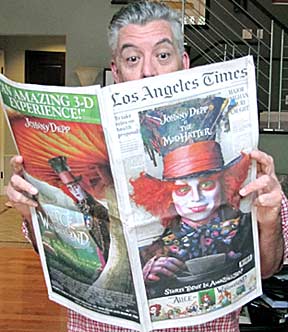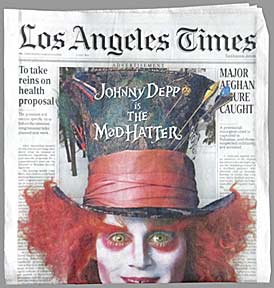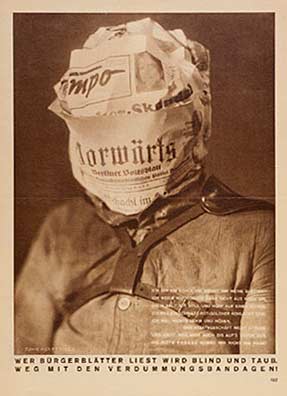Journalism in Wonderland

The Los Angeles Times abandoned all pretense of being a serious newspaper guided by high journalistic standards, when on March 5, 2010 the daily ran a full color paid advertisement as its front page rather than headlines and photographs from the news stories of the day.
It has been confirmed by the Hollywood news publication The Wrap, that the Walt Disney Company paid the Times approximately $700,000 to run a full color ad for the Disney-Tim Burton production of “Alice in Wonderland.”
The deal included not just the front page, but the inside front and back pages as well as the outside back cover of the publication.
Basically the entire newspaper was wrapped in an ad designed to look like an actual front page. A full color banner ad situated at the bottom of the paper’s genuine front page was also part of the deal, as was the incorporation of The Times masthead into the advertisement.

The spokesman for The Times, John Conroy, was quoted by The Wrap as saying the newspaper “worked very closely with Disney to come up with an exceptional and distinctive way to help them open Alice in Wonderland. It was designed to create buzz, and to extend the film’s already brilliant marketing campaign.” The New York Times quoted Conroy as saying that “It’s taking a concept that we normally apply to new media and reimaging it to a concept in a newspaper.”
What I find so appalling about the Times-Disney-Burton ad is its composition; it was laid over genuine news stories concerning President Obama’s healthcare “reforms” and his escalating war in Afghanistan. A gaudy photo of a heavily made up Johnnie Depp dressed as the demented Mad Hatter was superimposed over sobering news headings, partly obliterating them with the movie character’s top hat and flaming red hair. The underlying message, whether intentional or not, is clear; never mind those U.S. soldiers who are fighting, killing, and dying in Afghanistan – watch this movie.

That the newspaper would proudly transform its entire front page into a commercial platform for the promotion of a frothy Hollywood triviality – as the nation fights two wars while in the throes of extreme economic crisis – perfectly illustrates the state of journalism in the United States today. The alternative title to this article might just as well have been, “Journalism: Down the Rabbit Hole.”
Apologists for The Times are quick to mention that the paper is a business like any other, and that a severe recession and changing media landscape justifies any and all schemes to bring in revenue. Why not then replace the paper’s Editorial page with advertisements designed to appear as editorial opinions, or perhaps cease publishing hard news stories altogether in favor of celebrity and human-interest reportage, already a lucrative trend for corporate news outlets. To rationalize The Times’ abject surrender to commercialism misses the point; a news gathering organization that is beholden to advertisers will edit and modify content in order to please those advertisers, it is naïve to think otherwise.
It must be remembered that the Tribune Company, a Chicago based media conglomerate owned by billionaire real estate tycoon Sam Zell, acquired the Times Mirror Company and the Los Angeles Times in June of 2000 for $8.3 billion. The Tribune Company’s annual revenue is approximately $5.73 billion a year, and Mr. Zell’s personal net worth has been estimated to be around $6 billion. The Tribune Company owns 10 newspapers (including the Times and the second largest Spanish language paper in the U.S., Hoy), over 20 television stations (including L.A.’s KTLA), the WGN radio station in Chicago, and a number of other media assets that includes Chicago magazine and the Advocate Weekly Newspapers.
Under Zell’s ownership the Times has suffered massive staff cuts, with more than 300 newsroom personal laid off. The paper’s editor, James E. O’Shea, was fired in 2008 for resisting staff cuts. In 2009 the paper’s “California” section was done away with, eliminating the publication’s long established local news desk. It was then decided to fold local news into the paper’s front section – which was reorganized to de-emphasize national and international news. In a 2008 column for the Washington Post titled, The L.A. Times’s Human Wrecking Ball, journalist Harold Meyerson castigated Zell for being a “visiting Visigoth,” noting that the tycoon thought:
“there was too much coverage of world and national affairs, he told Times writers and editors; readers don’t want that stuff. Last week, the company decreed that its 12 papers would have to cut by 500 the number of pages they devoted every week to news, features and editorials, until the ratio of pages devoted to copy and pages devoted to advertising was a nice, even 1 to 1. At the Times, that would mean eliminating 82 pages a week.
(….) Voluntarily or not, large numbers of highly talented editors and reporters have left. The editorial staff is about two-thirds its size in the late 1990s, with further deep cuts in the offing. A paper that is both an axiom and an ornament of Los Angeles life, that helps set the political, business and artistic agenda for one of America’s two great world metropolises, is being shrunk and, if Zell continues to get his way, dumbed down.”
Observably, the Alice in Wonderland front page ad debacle is the ultimate expression of the dumbing down Meyerson forewarned of, and the Los Angeles Times has thoroughly trivialized and degraded journalism with the stunt. To be fair, the degeneration of the Times is part and parcel of the overall collapse of journalism in the U.S., as corporate news outlets abandon investigative journalism and insightful reporting on national and international affairs, for stories about car chases, the lives of celebrities, puppies, and other deadening inconsequentialities.
There is however another way of looking at the predicament; corporate “journalism” is not at all deteriorating, but fulfilling its mission of obfuscating and distracting. In his 1891 essay, The Soul of Man under Socialism, the writer and aesthete Oscar Wilde made an observation regarding the role of journalism that is pertinent to the topic at hand:
“What is there behind the leading article but prejudice, stupidity, cant, and twaddle? And when these four are joined together they make a terrible force, and constitute the new authority. In old days men had the rack. Now they have the press. This is an improvement certainly. But still it is very bad, and wrong, and demoralizing. Somebody – was it Burke? – called journalism the fourth estate. That was true at the time, no doubt. But at the present moment it is the only estate. It has eaten up the other three (….) In America the President reigns for four years, and Journalism governs for ever and ever.“
One can only imagine the caustic remarks Wilde would send flying at Sam Zell and the other potentates behind today’s 21st century media circus. When I first laid eyes upon that horrid Times cover I remembered Wilde’s shrewd comments about the so-called fourth estate, but I also thought back to an even more trenchant criticism of the press, a photomontage made in 1930 by the German artist John Heartfield, whose works regularly appeared in the pages of the left-wing Arbeiter-Illustrierte Zeitung (AIZ – Workers’ Illustrated Magazine).

Heartfield’s image depicted a man whose head was wrapped in the front pages of the two leading German Social Democratic newspapers of the day, Vorwärts (Forwards) and Tempo, the man’s swathed head being made to look like a cabbage. Heartfield placed text over the image that chided the Social Democrats for their centrist politics and accommodationist stance regarding Germany’s ruling class. The mocking caption was a parody of a Prussian patriotic song, “I am Prussian. Do you know my colors?” (which mentions the colors of the German flag), further linking the Social Democrats to the powers that be. Translated from German, Heartfield’s caption ran as follows:
“I am a cabbagehead. Do you know my leaves? I’m nearly out of my mind with worries, but I keep my mouth shut and hope for a savior. I want to be a black-red-and-gold cabbagehead! I don’t want to see anything, or hear anything, or get mixed up in public affairs. And you can take everything, even the shirt on my back, yet, I won’t let the Red press into my home!”
Along the bottom of the photomontage, Heartfield placed the following caption in bold text; “Whoever reads bourgeois newspapers becomes blind and deaf. Away with stultifying bandages!”

